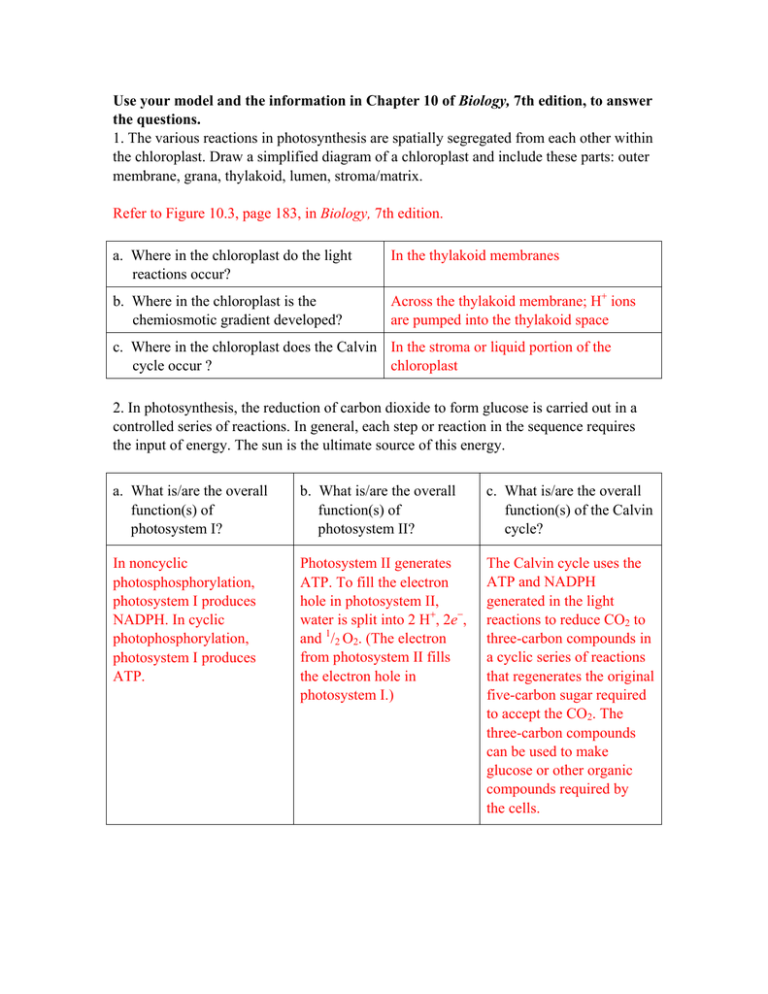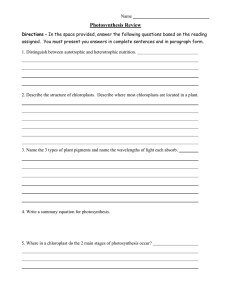Biology, 7th edition, to answer the questions.
advertisement

Use your model and the information in Chapter 10 of Biology, 7th edition, to answer the questions. 1. The various reactions in photosynthesis are spatially segregated from each other within the chloroplast. Draw a simplified diagram of a chloroplast and include these parts: outer membrane, grana, thylakoid, lumen, stroma/matrix. Refer to Figure 10.3, page 183, in Biology, 7th edition. a. Where in the chloroplast do the light reactions occur? In the thylakoid membranes b. Where in the chloroplast is the chemiosmotic gradient developed? Across the thylakoid membrane; H+ ions are pumped into the thylakoid space c. Where in the chloroplast does the Calvin In the stroma or liquid portion of the cycle occur ? chloroplast 2. In photosynthesis, the reduction of carbon dioxide to form glucose is carried out in a controlled series of reactions. In general, each step or reaction in the sequence requires the input of energy. The sun is the ultimate source of this energy. a. What is/are the overall function(s) of photosystem I? b. What is/are the overall function(s) of photosystem II? c. What is/are the overall function(s) of the Calvin cycle? In noncyclic photosphosphorylation, photosystem I produces NADPH. In cyclic photophosphorylation, photosystem I produces ATP. Photosystem II generates ATP. To fill the electron hole in photosystem II, water is split into 2 H+, 2e−, and 1/2 O2. (The electron from photosystem II fills the electron hole in photosystem I.) The Calvin cycle uses the ATP and NADPH generated in the light reactions to reduce CO2 to three-carbon compounds in a cyclic series of reactions that regenerates the original five-carbon sugar required to accept the CO2. The three-carbon compounds can be used to make glucose or other organic compounds required by the cells. 3. Are the compounds listed here used or produced in: Photosystem I? Photosystem II? Glucose Produced O2 Produced from the breakdown of H2O CO2 Used H2O Used to produce 2 H+, 2e−, and 1/2 O2 ATP ADP + P The Calvin cycle? i Produced (in cyclic photophosphorylation) Produced Used Used Used Produced NADPH Produced Used NADP+ Used Produced 4. Which light reaction system (cyclic or noncyclic) would a chloroplast use in each situation? a. Plenty of light is available, but the cell contains little NADP+. b. There is plenty of light, and the cell contains a high concentration of NADP+. If there is little NADP+, there must be much NADPH. This could occur if the Calvin cycle is not using up the NADPH. For example, if CO2 levels are low, little NADPH will be used to make glucose. Under these circumstances, the system would switch to cyclic photophosphorylation and gain ATP, which can be used both in photosynthesis and in other types of metabolism. In this case, it appears that NADPH is being used rapidly (therefore the high levels of NADP+). As a result, the system would switch to noncyclic photophosphorylation, which produces both ATP and NADPH. 5. All living organisms require a constant supply of ATP to maintain life. If no light is available, how can a plant make ATP? Keep in mind that it is not always light and that not all cells of a plant are directly exposed to light. For example, cells on the interior of a plant stem and those in the roots have little, if any, exposure to light. Plants, like other eukaryotic organisms on Earth, also contain mitochondria. Plant cells undergo glycolysis in the cytoplasm and transfer acetyl CoA to mitochondria, where it enters the Krebs cycle. The NADH and FADH2 produced during the Krebs cycle then undergo oxidative phosphorylation to produce ATP. How Do C3, C4, and CAM Photosynthesis Compare? 1. Carbon dioxide enters plant leaves through the stomata, while oxygen (the photosynthetic waste product) and water from the leaves exit through the stomata. Plants must constantly balance both water loss and energy gain (as photosynthesis). This has led to the evolution of various modifications of C3 photosynthesis. C3 Draw simplified diagrams of the cross sections of a leaf from a C3 ,a C4 and a CAM plant. See Figure 10.3. C4 See Figure 10.19. CAM CAM leaf anatomy is similar to C3 leaf anatomy. a. How are the leaves similar? All have stomata, epidermal cells that lack chloroplasts, mesophyll cells with chloroplasts, and veins that conduct water and the products of photosynthesis. b. How are the leaves different? C4 plants have large bundle sheath cells not found in the others. In C4 plants, the Calvin cycle occurs only in the bundle sheath cells. c. How and when does carbon dioxide get into each leaf? d. Which enzyme(s) (1) capture carbon dioxide and (2) carry it to the Calvin cycle? During daylight During cooler parts hours, when stomata of the day, when are open stomata are open At night, when it is cool and stomata are open The CO2 is picked up by the enzyme, rubisco, which catalyzes the first step in the Calvin cycle. PEP carboxylase in the mesophyll cells converts CO2 to a four-carbon organic acid, which is transported to the cells’ central vacuoles and can later be converted back to CO2 and PEP. The CO2 can then be picked up by rubisco and used in the Calvin cycle in mesophyll cells. PEP carboxylase in the mesophyll cells converts CO2 to a four-carbon organic acid, which is transported to the bundle sheath cells, where it is converted to CO2 and PEP, and rubisco catalyzes the first step in the Calvin cycle. e. What makes C4 photosynthesis more efficient than C3 photosynthesis in tropical climates? PEP carboxylase is much more efficient than rubisco at picking up CO2. As a result, C4 plants can capture large quantities of CO2 and store it as a four-carbon organic compound in a relatively short period of time. This means that during the hottest parts of the day, the stomata can close to reduce water loss. Even with the stomata closed, however, the Calvin cycle can continue by using the stored CO2. This system also maintains a relatively high ratio of CO2 to O2 in the cells that rely on rubisco, the bundle sheath cells. This greatly reduces the amount of photorespiration in these plants. f. How is CAM photosynthesis advantageous in desert climates? Stomata can be open at night when there is less evaporative loss of water and closed during the day. At night, PEP carboxylase allows desert plants to store CO2 as a fourcarbon organic acid. However, the amount that can be stored in the central vacuole of its photosynthetic cells is finite. This stored CO2 can then be used during the day to support the Calvin cycle. 2. Photosynthesis evolved very early in Earth’s history. Central to the evolution of photosynthesis was the evolution of the enzyme rubisco (an abbreviation for ribulose bisphosphate carboxylase oxidase). To the best of our knowledge, all photosynthetic plants use rubisco. Rubisco’s function is to supply carbon dioxide to the Calvin cycle; however, it does this only if the ratio of carbon dioxide to oxygen is relatively high. (For comparison, a relatively high ratio of carbon dioxide to oxygen is 0.03% carbon dioxide to 20% oxygen.) When the carbon dioxide-to-oxygen ratio becomes low, the role of rubisco switches and it catalyzes photorespiration, the breakdown of glucose to carbon dioxide and water. a. Why could we call photorespiration a “mistake” in the functioning of the cell? Photorespiration could be called a “mistake” because under high O2/CO2 conditions, rubisco breaks down glucose into carbon dioxide and water. No useful energy is gained from this, however. b. Rubisco is thought to have evolved when Earth had a reducing atmosphere. How does this help explain this “mistake”? When the first photosynthetic organisms arose, the early Earth’s atmosphere contained little, if any, oxygen. Rubisco would have functioned very well under these conditions. It was only later, when the concentration of oxygen in the atmosphere increased considerably, that rubisco’s ability to oxidize glucose became evident. 3. The metabolic pathways of organisms living today evolved over a long period of time—undoubtedly in a stepwise fashion because of their complexity. Put the following processes in the order in which they might have evolved, and give a short explanation for your arrangement. ___ Krebs cycle ___ Electron transport ___ Glycolysis ___ Photosynthesis First, glycolysis is found in all eukaryotes and many prokaryotes. It takes place in the cytoplasm and can occur in the absence of oxygen. Second, photosynthesis produces oxygen as a by-product. Neither the Krebs cycle nor electron transport can occur in the absence of oxygen. Third, electron transport is required to convert NADH to NAD+. Because glycolysis produces 2 ATP (net) and 2 NADH, the addition of electron transport represents an advantage. Organisms can then gain 8 ATP (net) from glycolysis plus electron transport. Fourth, the Krebs cycle cannot occur without a mechanism to convert NADH to NAD+. Electron transport must have evolved before the Krebs cycle.




